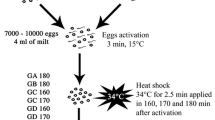Summary
Gametophytes of Pteridium aquilinum fed for six days with 50 and 75 p.p.m. thiouracil ceased to produce archegonia, but archegonia already initiated completed their development. Eggs produced in the presence of 50 p.p.m. thiouracil were viable, but embryogenesis was retarded. Gametophytes fed with 75 p.p.m. thiouracil mostly remained barren after insemination, the eggs being inviable, but others produced outgrowths from the archegoniate region which were either gametophytic, or sporophytic with a tendency to revert morphologically and functionally to gametophytic tissue.
Thiouracil administered after fertilization either prevented embryogenesis, or retarded it, the sporophytes then being deformed and often showing a tendency to produce gametophytic tissue. The embryo became less sensitive to short periods of thiouracil as it developed, possibly because of the appearance of relatively quiescent regions, serving as reservoirs of unaffected cells.
The results are held to support the view that the genes responsible for sporophytic growth become activated during oogenesis, and that the cytoplasm of the mature egg already contains the information leading to this kind of growth.
Similar content being viewed by others
References
Bell, P. R.: Interaction of nucleus and cytoplasm during oogenesis in Pteridium aquilinum (L.) Kuhn. Proc. roy. Soc. B 153, 421–432 (1960).
—: The archegoniate revolution. Sci. Progr. Oxf. 58, 27–45 (1970).
—, Richards, B.: Induced apospory in polypodiaceous ferns. Nature (Lond.) 182, 1748–1749 (1958).
Brockman, R. W., Anderson, E. P.: Pyrimidine analogues. In: R. M. Hochster and J. H. Quastel eds., Metabolic inhibitors, vol. I, p. 239–285. New York: Academic Press 1963.
Heslop Harrison, J.: Effect of 2-thiouracil on cell differentiation and leaf morphogenesis in Cannabis sativa. Ann. Bot., N.S. 26, 377–386 (1962).
Jayasekera, R. D. E., Bell, P. R.: The effect of various experimental treatments on the development of the embryo of the fern Thelypteris palustris. Planta (Berl.) 54, 1–14 (1959).
—: The synthesis and distribution of ribonucleic acid in developing archegonia of Peteridium aquilinum. Planta (Berl.) 101, 76–87 (1971).
Moore, G. T.: Methods of growing pure cultures of algae. J. appl. Micr. 6, 2309–2314 (1903).
Munroe, Marian H., Bell, P. R.: The fine structure of fern root cells showing apospory. Develop. Biol. 23, 550–562 (1970).
Ward, M., Wetmore, R. H.: Experimental control of development in the embryo of the fern, Phlebodium aureum. Amer. J. Bot. 41, 428–434 (1954).
Author information
Authors and Affiliations
Rights and permissions
About this article
Cite this article
Jayasekera, R.D.E., Bell, P.R. The effect of thiouracil on the viability of eggs and embryogeny in Pteridium aquilinum . Planta 102, 206–214 (1972). https://doi.org/10.1007/BF00386891
Received:
Issue Date:
DOI: https://doi.org/10.1007/BF00386891




